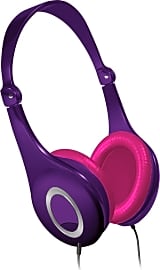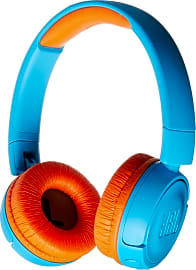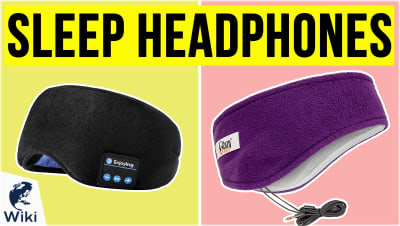The 6 Best Kid's Headphones

This wiki has been updated 40 times since it was first published in July of 2016. All kids love to listen to their choice of music, TV shows, video games, and movies, but not every parent enjoys those same types of media. Give your youngster the freedom to listen to whatever he or she wants at any time with a pair of these headphones for kids. Boasting colorful and snazzy designs, they also feature noise-limiting technology to protect young eardrums. When users buy our independently chosen editorial choices, we may earn commissions to help fund the Wiki.
Editor's Notes
July 30, 2021:
The entire point of kids' headphones is safety, so we dug deep to make sure we only included models that are limited to 85 decibels or less. After checking on some real-world testing, this actually knocked a few prominent models off our list, including two from popular LilGadgets that consistently exceeded the recommended safe volume level as well as most other options.
Our top spot is still occupied by the Puro Sound Labs BT2200, which are the best in terms of sound quality. Of our newcomers, the JLab JBuddies Studio are the best for adolescents, the Onanoff BuddyPhones Explore are ideal for toddlers, and the Maxell Safe Soundz come in a couple varieties for kids in between.
April 21, 2020:
A few of the models on our previous list were not volume-limiting, and while we took pains to point that out in their listings, we thought it would be far more appropriate to set a standard against any headphones for children that didn't limit volume. That said, there is some difference in the way certain models limit volume. That's because there are two separate thresholds in place depending on which organization you're citing, with one saying anything above 85 decibels is dangerous, and the other camp saying things are safe up to 93 or 94dB. Most models will stick to one of these numbers, though some, like the MPow Wireless Foldable, let you choose which level to use, and still others like the LilGadgets BestBuds, cap their drivers at an even lower volume level.
There were also a few models whose durability was called into question after enough use like the JLab Audio JBuddies, and the Onanoff Explore actually did away with their folding mechanism, making these unreasonably difficult for travel. These were removed from our ranking.
In the places of these models, we attempted to find as many high-quality offerings from recognizable brands as we could. That's what brought both the Philips SHK2000PK and the JBL JR 300BT to our ranking. If this is your first foray into kids cans, however, you might not immediately recognize the company behind the LilGadgets Untangled Pro, but these are among the finest models out there, with a reliable wireless connection, high-quality build, good battery life, and 40mm drivers for top-tier sound quality.
Special Honors
Moki Safe Volume Limited If you want the things you get for your children to last more than a few months to a year, these might be your best bet. They're comfortable, adjustable, and well-made, and they limit their sound to 89dB, which is a little louder than a lot of the competition, but still within a relatively harmless range. They boast a four-foot cable with gold-plated contacts, but it isn't detachable. mokiinternational.com
A Brief History Of Headphones
While they may be nearly ubiquitous today, headphones have a long technical history that dates back to the early 20th century.
While they may be nearly ubiquitous today, headphones have a long technical history that dates back to the early 20th century. The earliest sets were developed for listening to Mormon church services, though the technology was quickly bought by the US Navy. The original versions worked in much the same way they do today.
Essentially, their job is to convert electronic signals into sound waves. This is achieved by a magnet which exerts pressure on a diaphragm, which, in turn, vibrates, creating an audible signal. If you've ever seen the front part of a speaker visibly vibrating, you're familiar with what this looks like. Headphones work in just the same way, but scaled down for your ears.
The original versions were uncomfortable and had terrible sound quality. It wasn't until the late 1950s that consumers started using them to listen to music. Until that point, they were used almost exclusively by telephone and radio operators. The shift came with the 1958 invention of stereo headphones by jazz musician John C. Koss. Today, the Koss Corporation is one of the most respected manufacturers of high-fidelity headphones and audio equipment.
Soon after the first pair of stereo headphones was introduced, earbud-style models were developed. Originally intended for use as hearing aids, they became popular for use with transistor radios. These were becoming increasingly portable at the time, lending themselves well to listening on-the-go, which consumer headphone models further enabled.
As devices for listening to recorded music became increasingly portable, the demand for headphones rose in tandem. Over time, the jack of choice for most models shifted from the original 1/4-inch style, which dates back to 1878, to the more compact 3.5mm jack, which is the standard today. It was developed in the 1950s and buoyed by various Sony products: first, the EFM-117J radio in 1964, and then by their Walkman line, which was released in 1979.
While 3.5mm ports are still found on most computers, phones, stereos, and other music-listening devices, wireless headphones have become increasingly popular in recent years. These primarily use Bluetooth technology and typically have a range of up to 30 feet. In most cases, they boast premium sound quality and make it possible to unburden users from the tyranny of cords. Whatever your stance is on the new technology, its presence is undeniable, and it will only become more popular as more and more devices begin to eschew the analog headphone port.
The Benefits of Children's Headphones
Headphones are useful for isolating sound, keeping yourself focused in a frantic environment, and keeping your musical selections to yourself while in public. Unfortunately, they can also be dangerous for young ears. Over the past few decades, hearing loss among teenagers has been on the rise. This can be attributed in part to the widespread use of headphones pumping loud music straight into their ears.
That's approximately the volume of a large room full of people talking, or the ambient noise of heavy traffic.
Sound is measured in decibels. The average music player can reach volumes of up to 105 decibels, while most concerts peak around 110. The reality is that any noise above 85 decibels can potentially damage a child's eardrums, resulting in hearing loss. That's approximately the volume of a large room full of people talking, or the ambient noise of heavy traffic.
Standard headphones are designed to reproduce the range of volumes supported by the device to which they are connected. While that accuracy is welcome for adults, you might not want to expose your child's ears to the loudest setting available on their iPod. Thankfully, there are a number of solutions to this problem. These include the use of ear plugs in loud settings and, of course, headphones designed for kids.
Kids' headphones are designed to limit the maximum volume to levels well below the danger zone. That way, even when they listen to their music with the volume all the way up, their ears stay protected. Of course, the headsets are made to fit comfortably on the heads or in the ears of youngsters, as well.
Giving your child their own pair of headphones also encourages them to take ownership of their entertainment. It's a great way to help them start building their own tastes and preferences when it comes to music. Just make sure they're not hurting themselves inadvertently if they happen to prefer Metallica to Chopin.
A Note About Noise-Induced Hearing Loss
It's important to remember that, even though it might not seem like a big deal, exposing children to loud noise can do permanent damage. In truth, more than an hour per day of music or noise at the comparatively safe volume of 85 decibels can do harm. For that reason, if you do buy headphones for your child, it's still recommended that you keep the time they spend listening at full volume to a minimum.
About one in every eight children has permanent damage done to their hearing by the end of their teen years.
In addition to pain and inconvenience, the secondary effects of hearing loss are many, and include difficulty communicating, socializing, and even learning. Students who have suffered hearing loss even in mild amounts underperform in school when compared with their peers.
The problem is widespread. About one in every eight children has permanent damage done to their hearing by the end of their teen years. That number increases to about one in six among adults. Noise-induced hearing loss can't be fixed, even through surgery. That's why it's important to take every possible precaution when it comes to your child's ears.
Of course, noise exposure is not the only way a child can lose his or her hearing. There are a number of conditions that can cause hearing impairment at birth, and many of them are genetic. Untreated ear infections, perforated eardrums, head injuries, and second-hand smoke exposure can also lead to acquired hearing loss.
There are various milestones associated with how your child should respond to sound as they grow. If you're unsure about the health of your baby's hearing for any reason, it's a good idea to consult your doctor sooner rather than later.











